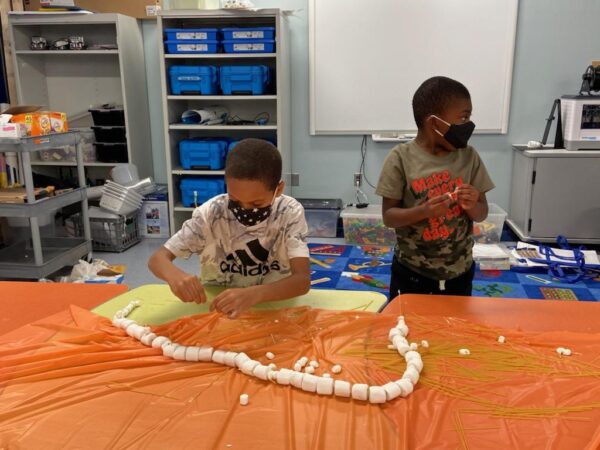
(Updated, 2:50 p.m.) A new, free literacy program has come to Drew Elementary School thanks to the local non-profit Sliding Doors, Virginia Tech, and the local NAACP branch.
The Dyslexic Edge Academy launched this week with 11 first graders at Drew Elementary in Green Valley. The goal is to help those students who struggle with reading by focusing on their strengths.
“People with dyslexia tend to gravitate to and be very good in STEM fields; science, technology, engineering and math,” Krista Gauthier, executive director of Merrifield-based Sliding Doors, tells ARLnow.”What we want to do is not only make sure that kids receive the evidence-based instruction that they need, but also play on their strengths. To us, confidence is as important as reading.”
The students meet with instructors after school in a group setting twice a week for 90 minutes. Half of the session is spent with one-on-one tutoring using the Orton-Gillingham approach, which breaks down reading and spelling using multisensory skills like sounds and hand motions. The other half of the session is spent on STEM-related projects.
“The STEM activities include everything from kitchen chemistry to rocketry to robotics to coding,” says Gauthier.
That could mean making slime, building model rockets, or operating an underwater robot, she says. It’s hoped that field trips to the National Geospatial Intelligence Agency and the Smithsonian could be part of the curriculum in the future as well.
While the program is starting with 11 students, the expectation is that it will have 20 students by early next year. The pilot program will run until at least May 2023.
About 20% of the population has some form of dyslexia, according to statistics from the Yale Center for Dyslexia and Creativity. Yet, many school systems haven’t adapted to help these students and private tutoring can be prohibitively expensive, explains Symone Walker, co-chair of the Arlington Branch NAACP Education Committee.
She believes this is a big reason why there’s such an opportunity gap at some Arlington schools, including Drew Elementary.
“We really wanted to target a population that has been disproportionately impacted by the achievement gap,” says Walker. “We’re very familiar with how Drew has been historically passed over, looked over in the community, and we wanted to give back where we saw the greatest need.”
Both Walker and Gauthier say that the opportunity and achievement gaps that exist in county schools have a lot to do with reading scores and how schools are teaching literacy.
The Dyslexic Edge Academy will use the multisensory Orton-Gillingham approach to teach reading, as opposed to the balanced literacy approach that’s currently being taught in Arlington public schools.
“When we talk about multisensory, we’re talking about big motions,” says Gauthier. “We actually use something called ‘skywriting,’ which is as the child is actually forming the letter in the air… they’re actually saying the letter, repeating the letter, attaching the sound to the letter.”
What’s more, by bringing cool STEM-related projects into the learning, it helps students gain confidence.
“They really begin to associate something they struggle with, with something they love,” says Gauthier. “It really actually plays into them wanting to read as well.”
As Walker points out, a lot of NASA employees have some form of dyslexia. In fact, that includes more than half of NASA employees, according to the Yale Center for Dyslexia and Creativity.
“We want to produce more Arlingtonians who work for NASA,” she said.

